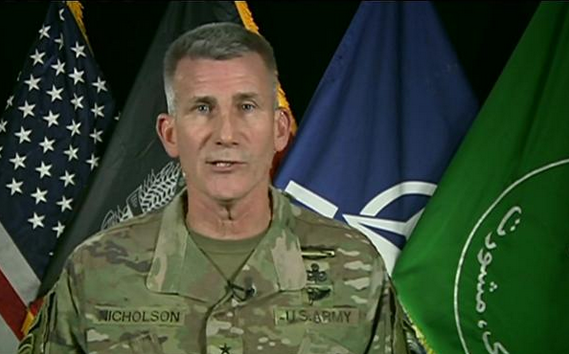
US Army Gen. John Nicholson, commander of US Forces-Afghanistan, briefs reporters via a video feed on Nov. 28, 2017. Screenshot of DVIDS video.
Three days of intense airstrikes on Taliban drug-making and financial facilities took out up to $10 million of the group’s funding, part of a shift on airstrike targeting, the top US officer in Afghanistan said Tuesday.
The Taliban has evolved into a “criminal/narco insurgency” in Afghanistan, focused on fighting to defend its “revenue streams,” US Army Gen. John Nicholson, commander of US Forces-Afghanistan, said during a Tuesday briefing.
“They have increasingly lost whatever ideological anchor they once had,” Nicholson said. “They fight to preserve and expand their sources of revenue. This includes narcotics trafficking, illegal mining, taxing people throughout Afghanistan, kidnapping, and murder-for-hire: all criminal endeavors.”
In response, US forces conducted three days of airstrikes, including B-52 and F-22 missions, hitting opium production facilities in Helmand Province. These strikes, coupled with efforts by the Afghan 215th Corps, took away between $7 million and $10 million.
“These strikes were just the first step in attacking the Taliban’s financial engine, and they will continue,” Nicholson said.
So far this year, US forces have tripled the number of air-delivered munitions dropped on Taliban and ISIS targets in Afghanistan. That number will increase as more aircraft are shifted away from Iraq and Syria, Nicholson said.
The Taliban still has a strong hold on territory and the population inside Afghanistan. Sixty-four percent of the country is controlled by the Afghan central government, with 12 percent controlled by the Taliban, and 24 percent of the population lives in contested areas, Nicholson said.